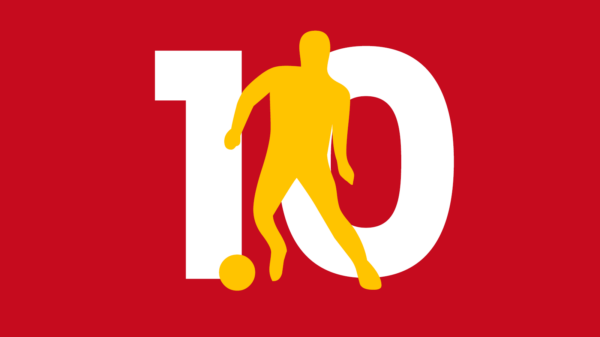Thomas Sorensen provides a detailed tactical analysis of the La Liga game that finished Barcelona 1-2 Alavés.
This past Saturday evening saw the Basque La Liga newcomers, Deportivo Alavés, grab a sensational win at the Camp Nou, winning 1-2 versus a reserve packed FC Barcelona with Neymar leading the line.
Barca played a lot of their reserves in their usual 4-3-3 formation for this match, as Luis Enrique handed debuts to both Jasper Cillessen in goal and Paco Alcacér up front. With both Messi and Suárez on the bench, Neymar was the man to lead the show for this Barcelona offense.
Deportivo Alavés, with head coach Mauricio Pellegrino, opted for a defensive and very compact 5-4-1 with the Levante-loanee Deyverson up top, giving them a threat on the counter. The wide defenders were mainly used as traditional fullbacks and didn’t go forward compared to wingbacks in other systems using a 5-man backline.
Alavés’ successful deep block
Alavés coach Mauricio Pellegrino had set up his team in a very compact deep block, with the intention of defending the middle of the pitch. In the below graphic, one can see a very common scenario in the game:
Alavés is standing in a very horizontally compact block with all 11 players behind the ball. This made it very difficult for Barcelona to play between the lines and penetrate the Alavés defense with quick combinations. You can also see a key point in Alavés’ defensive strategy, as they have trapped Busquets inside a triangle of Deyverson, Marcos Llorente, and Daniel Torres, making it very difficult for the midfield maestro to receive the ball.
This deep compact block made it easy for the Catalans to get the ball into their opposition half, as Alavés only attempted very little and not that successful pressing higher up the pitch. But when Barca entered the last part of Alavés’ half was when they faced problems. Alavés would start their pressing in this zone giving Barca very little time on the ball to get their combinations going. Behind the black line on the graphic below is where they would usually start their pressing.
This strategy proved very successful when you look the passes into the area on these dashboards from Four Four Two. To the left, you can see all of Barcelona’s successful key passes into the area, and then on the right all of their passes on the last third of the pitch. Here it’s most important to notice all of the red passes into or on the edge of the area, as that were where Alavés were very successful, by forcing them to the side or closing the line into the area.
When the passes into the men between the lines were made, the two Alavés-defenders did really well to step out of their backline and avoid the Barcelona-players from turning their face to goal in front of the area:
This Alavés side seemed to have pretty good relations between the players defensively. In the gif below, you can see how they support each other when they start pressing. Both deep and higher up their own half. This was extremely important, as if anybody didn’t follow up on their teammates pressing, they would expose their defense and let Barcelona find the space behind them.
With 17 new signings and 6 of them being on the pitch, this is pretty good work from head coach Mauricio Pellegrino.
Barca’s change of shape
About 30 minutes into the first half Barcelona changed their shape from their classic 4-3-3 with two central defenders in front of the opposition’s first line, Busquets between the first and second line, the two full-backs pushed high up the field, two central midfielders in the half-spaces and the three up front dynamically changing positions as shown on this picture:
But as mentioned before, Busquets did not have the influence that Barcelona wanted him to have, due to Alavés’ well-organized defensive block. That made Luis Enrique change his build-up shape to a 3-2-4-1 in possession. Barca would now put Busquets as the middle man in the first line of their build up play. They hoped that he would now have more time with the ball and be easier accessible for his teammates when he was not locked into the triangle as shown earlier.
This new formation also gave FC Barcelona more presence between the lines. Neymar and Arda Turan would now operate more centrally and in the half-spaces, and with either of the two central midfielders pushing up and Paco dropping down between lines, they would now have a higher presence between the lines. This change of formation came as a direct consequence of Barcelona’s problems with penetrating Alavés’ well-organized block.
In the second half, Mascherano and Busquets switched positions. That would now leave Mascherano as the middle man in the first build-up phase and Busquets to the right, giving Busquets more space to receive or drift the ball forward to more advanced positions on the field, to take advantage of his great ability to break the opposition’s defensive lines.
Though it did not have the effect Enriques men hoped for, as Alavés kept covering the middle effectively. On this dashboard on Busquets passing in the attacking third in the second half from Four Four Two, you can see that it ended up in a lot of sideways passes or diagonals from the Spanish international instead:
Paco Alcácer’s bad link-up play leaves offensive responsibilities to Neymar
The new signing from Valencia, Paco Alcácer, was handed his debut by Luis Enrique but did not exactly give him any hard choices regarding his next starting lineup. Paco did not contribute much to Barcelona’s attacking during the first 65 minutes of his Barcelona-career. As shown on the Four Four Two dashboard of all his received passes, he only managed to receive the ball 9 time inside Alavés’ half of the pitch and only 2 times in the area, leading to only one shot, which he fired wide. It was very clear that Paco isn’t properly installed to this Barcelona-team yet, and it will probably take him some time to fit into the quick combination attacking-style Barcelona plays.
The quiet performance of Paco did leave most of the offensive responsibility to Neymar. But the Brazilian superstar only found his way into the Alavés area rarely. Attempting 10 take-ons but only succeeding with 4 of them must be considered a below-par performance by his standards. Though Neymar will get an assist for his corner to Mathieu’s headed equalizer – but it could have been one more if Mathieu hadn’t missed an even bigger chance on another corner moments after. By the 60 minute mark Luis Enrique had had enough and subbed on Messi, Iniesta, and Luis Suárez within 5 minutes but none of them managed to have a decisive impact on the game with only one chance coming to Messi in the dying seconds of the game.
Conclusion
Managing only 2 shots inside the area Deportivo Alavés got away from the Camp Nou with a sensational 2-1 win from two big mistakes from Argentine international Javier Mascherano. Despite Barcelona having 74% possession of the ball and having 13 corners against Alavés’ 0, Alavés took their chances and did really well in staying compact and leaving very little space to the Catalans for getting their quick combination game started. And very unlike Barcelona, their goal and their greatest chance came from corners to defender Jérémy Mathieu. Though this is just another proof of how great Alavés did in shutting down the likes of Neymar, Busquets, Arda Turan, and later on substitutes Lionel Messi and Luis Suárez. This will without a doubt give Alavés a great boost in their fight against relegation, going to the Camp Nou and deliverong such a performance, in what might be the biggest game so far in a lot of the players from the Basque side’s careers. Barcelona loses 3 points in the fight for the La Liga trophy and leaves Real Madrid alone at the top of the table. Luis Enrique might get blamed for taking the task too lightly and playing too many reserves, and lacking ideas when they couldn’t penetrate with their passing and are forced to cross the ball. They will hope next week’s opponents won’t have learned too much from their fellow promoted side, as they go to Batarque to play Leganés.
Read all our other Tactical Analyses here.
- Tactical Analysis: Atletico Madrid 5-0 Gijon | Atletico outpress the opposition - September 21, 2016
- Tactical Analysis: Barcelona 1-2 Alavés | Alavés get sensational win at the Camp Nou - September 16, 2016





































































